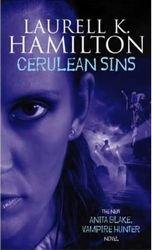Anita Blake, Vampire Hunter - Laurell K Hamilton
Review continued
In a much later book, Cerulean Sins, unwilling to join with the high mother of a family of vampires she is cast into primordial night, within which nothing yet lives or moves other than a remorseless hunger, hunting her down. How, we wonder, can anyone escape this? What inner resources would be needed to retain some vestige of integrity? She meets the All-Mother of vampires. And the consequences are horrendous, as she gradually becomes more monster than human.
This is high imagining.
And Hamilton has the craft to not only convey these experiences believably, but she can also play with them: as Anita Blake goes through this ultimate ordeal she is in a car driven by fellow 'creatures', being chased by suspicious types down a freeway in St Louis. Beat that.
The society of the vampires etc is full of complex rules, allegiances and families. Every vampire belongs to the family that turned him or her; the families can stretch back centuries, and their living progenitor can be immensely old and powerful. The vampires have a legal church, though not allowed to recruit. What if, one book asks, a young son or relative wants to join their church, in effect, to choose to die, and live the life of a monster? How would we deal with that? How can you hold off a vampire utilising an image from a church, a religion, that did not even exist when this vamp was alive?
The books, as fantasy, cause us to deal with the very real horrors of our contemporary world.
Sociopathic? Ok, it's in the mentor-disciple relationship of Anita and Ted. Cold and conscienceless killers. Ted takes to hunting the 'monsters' because humans are too easy. And Anita: Anita is to them the Executioner, whereas Ted is known simply as Death. But Anita evolves, she becomes more of a monster as her abilities increase. She baulks more at the outright killing; it is still as savage: kill or be killed, but she understands more the why of it. That makes the difference. She still does not hesitate but recognises where there is no mercy possible, and where there is. Ted, meanwhile attempts the impossible: to live an ordinary life with wife and kids, surprised more than anyone to find a flicker of emotional integrity left.
We also find in the books descriptions of the victims, monster-killings; Anita Blake needs to examine them to determine cause of death: human or monster. And so we also glimpse them, bloody stumps, gnawed bones, decapitations and all. It is not CSI so much, but the implied fascination with viscera is there all the same. Admit it, are you fascinated? Remember what I said earlier about research…?
We find precedents for character-types in other literature. Anne Rice's Lestat novels are an obvious source for Jean-Claude, Master of the City. The developing ménage-a-trios between him, Anita, and lycanthrope chief Richard becomes dominant. In fact Jean-Claude is more a bi-vamp, when his male lover turns up. There are invitations by female vamps, but Anita is not interested.
We can see off-shoots into the Vampire Wars series of Darren Shan: the emphases on violence, fighting, in that both authors have their creatures spend most of their spare time in spats with one another. On a far more vicious scale, of course. We can also detect Shan's visceral Demonata series paying homage here.
The hard-boiled, quick-tongued quipping detective fiction is also referenced, with honours. From the early quips and tough-guy talk of The Virginian, through the Marlowe novels, to the wide spin-offs of Elmore Leonard et al.
Don't forget Buffy the Vampire Slayer tv series. The series began in 1997, following the film. By this time Anita was well in her stride. It is in the quick quips, the one-liners which Buffy was top-notch for.
The only exotica I do have trouble with in the books is the faerie/fey. Bloody Bones is the main culprit here. Although Hamilton fights valiantly to draw the book back into sterner stuff, the fey do not convince.
The later books become increasingly explicitly erotic in content, the sexual atmosphere dominates, steams off the pages; vampires and others have the ability to unleash their sexual energy so that it can 'roll' another, even at a distance. Vampires also can sickeningly be traded as sexual toys amongst the older, powerful family elites. Etiquette demands when a senior makes a house call that playmates must be provided for the whole retinue. Willing, or not.
Sado-masochism, dominance and submission, even beast fantasies, all occur in the novels.
And how do they feed? Are they as rapacious as other books have it? Not a bit. The vamps, the masters, have their dedicated humans willing to give food; the homoerotic element comes across most strongly here. Hamilton glories in her descriptions of the young men, their complex textures of clothing, the scent of their (unanimously) long hair, their muscular bodies. Are these the things we begin to discover we have learnt to denigrate?
Because Hamilton loves the male body; she tenderly describes its smells, its textures, the particulars of male sexuality - the tendernesses of the were-males who withhold the violence of their passions in respect to their human partners. How respectful they all are, how disciplined, and how reverently they take to the bed.
I can't help wishing they'd laugh more, not the hard-edged laughter like sharp tin, but proper belly laughs, the pant-wetting stuff. You know what I mean.
Do you ever think of death, your death? And, well, would you, if it was real? My friends would have most trouble with the bed-at-dawn rule, I reckon.


